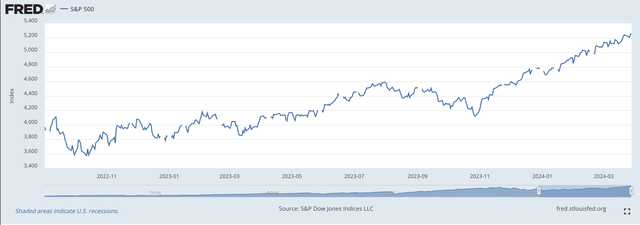sitox
The S&P 500 hit a new all-time high on Thursday.
This is the 22nd “all-time high” this year.
There are several things to focus on.
First, the economy is doing well.On Friday, numbers for the fourth quarter of 2023 will be released It has been revised upward.
Second, excitement about artificial intelligence technology continues to be high.
Third, there are expectations that the Fed will cut interest rates at least once, if not two or three times, this year.
It's also worth noting that consumer confidence has risen to its highest level in nearly three years.
And there seems to be a lot of money.
Looking at the Fed's financial statistics, the M2 money stock has been increasing at a compound annual growth rate, despite two years of quantitative tightening by the Fed on the banking system. 8.0% in the past four years.
In other words, economic conditions look pretty good, which bodes well for the stock market to rise further.
One issue that seems to remain a concern is that of inflation.
The latest inflation numbers are better than expected…or better than hoped for.
In response, Federal Reserve President Chris Waller said that given this recent information, there is “no rush” to lower the Fed's policy rate.
But this story is longer than this.
Let's take a look at how the S&P 500 stock index has performed over the past 18 months.
S&P 500 Stock Index (Federal Reserve)
The bottom of the S&P 500 index in mid-October 2022 was 3,577.
On Thursday, March 28, 2024, the S&P 500 closed at 5,254.
That's a 46.9 percent increase…not that bad.
This is not an outcome that can be achieved by a market where investors are hungry for money, where the economy is entering or is in recession, or where there is nothing positive to grab onto.
And it looks like the positive news continues.
In the 2010s, Fed Chairman Ben Bernanke launched the Fed on a new model for achieving economic growth with only moderate inflation.
This model centered around a “new” approach to monetary policy: quantitative easing…or quantitative tightening.
This is the basis of what is happening now.
Mr. Bernanke wanted to create an environment in which monetary policy would contribute to rising stock prices, which would increase consumer wealth and eventually support economic growth.
And there probably won't be much, if any, driving inflation.
Looking back over the past 15 years or so, the policy structure Mr. Bernanke put in place appears to have worked.
And it seems to be working well for now, even though we are in a period of quantitative tightening.
The Federal Reserve pumped a lot of money into the economy through quantitative easing. Over the past two years, the Fed has carefully tried to remove some of this money and rein in inflation.
This policy seems to be working very well.
Meanwhile, stock prices continue to rise and rise, and investors profit from their efforts.
oh!
It increased by 46.9% in two years.
Current Fed Chairman Jerome Powell recently talked about reducing the amount of quantitative tightening that is taking place.
But this is still in the future.
And, as Governor Waller said, quoted above, there is “no need to rush.”
Still, the basis of the Fed's policy stance is what it will do to reduce or increase its securities portfolio.
I don't want to move too quickly. And what we are currently relying on is something called “forward guidance.” Fed officials are “talking” about what will happen in the future.
This helps set the tone for the market.
And over the roughly 15 years that the Fed has been implementing this program, markets — investors — seem to have shown a great deal of “confidence'' in the actions of Fed officials.
As a result, investors can expect more of the same in the future.
I think this is a very positive conclusion for the future of the stock price.


